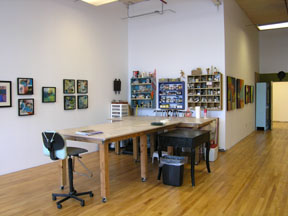Artists painting a sculpture of Herakles, Red Figure Apulian Column Krater.
GREEK Anonymous , 4th BCE Greek Classic Ceramics
Earthenware | Italy. | New York. Metropolitan Museum of Art.
I was finally able to get this picture from a classical Greek vase dug up in Italy . The image appears on the cover of the 13th edition of Gardner's Art Through the Ages, as I saw on Amazon, but I couldn't get it from there. Neither did it turn up on the searches I made of the Metropolitan Museum which now owns the vase. Google eventually found it at gallery.sjsu.edu/arth198/
Here is the painter's nude assistant manning the charcoal brazier containing cylinders of molten encaustic and heated tools.
And on the other side of the statue, the bearded artist applies the paint to Herakles's lion skin cloak.
I also found an image of these tools, called cauteria in the plural (cauterium, singular), that were used to apply and smooth the wax.
I wish I knew who the figure was that is shown above the assistant. I guess it must be the god Herakles (also known as Hercules) watching his statue get painted. I didn't think that Hercules was a god, but I just read up on him and found that he was the son of Zeus and a mortal woman and so was a god. (Note: one of our dogs is named Hercules and we treat him like a god.)
Addendum: Joanne Mattera sent me some images she took of this vase at the Metropolitan Museum. These are just great for getting a sense of the size of the piece and clarity of the images.
When you look at these images, you can see that it is Daddy Zeus above the assistant on the left and then Herakles (Hercules) in the flesh looking on at the painting from the right.
You can tell it's him because of the lionskin cloak and the club.
A very big thank you to Joanne for sending me these irreplaceable images of what is believed to be the only depiction of an encaustic painter plying his trade on a statue.
_________________________________________________________________________
On another note...
So encaustic is much on my mind, and looky here, what I got via email:
I am so happy to be included in this show and to have an image (cropped) of my work appear on the card and in the press release. I wish I could go to Tucson for the opening but it's not in the cards right now. Maybe next time. The wonder of it all is that I know just about every one of the artists included in the show thanks to the encaustic conference. And of course I know Miles Conrad from the conference, too. That is such a nice feeling to be among friends even in absentia.















3 comments:
I really enjoyed your visual interpretation of the Greek vase decorations. This is so marvelous, and also the plate of the tools! Hope that the students enjoyed it as well.
I'm enjoying all your research ! :) Congrats on the show/card...got it last week! Have a blast with those Smith kids.
So cool Nancy, this show! I love your work and glad it is recognized. I love too the piece on the vase. Now I want to go see the real thing. I loved too your description of setting up for all those students and then what to do when they were working. Sort of like Christmas let down. You did weeks of prep and then they were on their own. Sign of a great teacher. Congrats! Of course I already know you are a great teacher.
Post a Comment